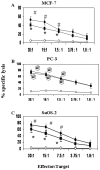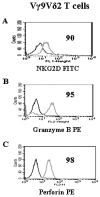Lysis of aminobisphosphonate-sensitized MCF-7 breast tumor cells by Vγ9Vδ2 T cells
- PMID: 21069948
- PMCID: PMC2999943
Lysis of aminobisphosphonate-sensitized MCF-7 breast tumor cells by Vγ9Vδ2 T cells
Abstract
Aminobisphosphonates are drugs administered for the treatment of bone resorption. They can indirectly activate peripheral γδ T cells and render tumor cells susceptible to lysis by Vγ9Vδ2 T cells. We have investigated the molecules involved in conjugate formation and killing of aminobisphosphonate-treated MCF-7 breast tumor cells by Vγ9Vδ2 T cells. Lysis of aminobisphosphonate (Pamidronate and Zoledronate)-treated MCF-7 tumor cells by Vγ9Vδ2 T cells was assessed by chromium release assays and time-lapse video microscopy. MCF-7 breast cancer cells were chosen as aminobisphosphonates are employed to alleviate bone resorption in this malignancy. Cell cycle profile and expression of MICA, ICAM-I and FasL on aminobisphosphonate-sensitized MCF-7 breast tumor cells was confirmed by flow cytometry. Involvement of γδ TCR and NKG2D in mediating cytotoxicity of aminobisphosphonate-treated MCF-7 breast tumor cells by Vγ9Vδ2 T cells was assessed using blocking antibodies in chromium release assays. MCF-7 tumor cells pretreated with Pamidronate and Zoledronate were efficiently lysed by Vγ9Vδ2 T cells. Pamidronate and Zoledronate treatment of MCF-7 cells induced S phase arrest and did not alter expression of MICA, ICAM-I and FasL. Blocking γδ TCR and NKG2D on Vγ9Vδ2 T cells inhibited lysis of Pamidronate and Zoledronate-treated MCF-7 cells. Inhibiting the perforin-granzyme pathway in Vγ9Vδ2 T cells using concanamycin A reduced their ability to lyse aminobisphosphonate-treated MCF-7 cells. Vγ9Vδ2 T cells form strong conjugates with aminobisphosphonate-treated MCF-7 breast tumor cells. γδ TCR, NKG2D and perforin-granzyme pathway are involved in the lysis of MCF-7 breast tumor cells treated with aminobisphosphonates by Vγ9Vδ2 T cells.
Figures
References
-
- Thedrez A, Sabourin C, Gertner J, Devilder MC, Allain-Maillet S, Fournie JJ, Scotet E, Bonneville M. Self/non-self discrimination by human gammadelta T cells: simple solutions for a complex issue? Immunol Rev. 2007;215:123–135. - PubMed
-
- Green JR. Antitumor effects of bisphosphonates. Cancer. 2003;97:840–847. - PubMed
-
- Kunzmann V, Bauer E, Wilhelm M. Gamma/delta T-cell stimulation by pamidronate. N Engl J Med. 1999;340:737–738. - PubMed
-
- Dieli F, Gebbia N, Poccia F, Caccamo N, Montesano C, Fulfaro F, Arcara C, Valerio MR, Meraviglia S, Di Sano C, Sireci G, Salerno A. Induction of gammadelta T-lymphocyte effector functions by bisphosphonate zoledronic acid in cancer patients in vivo. Blood. 2003;102:2310–2311. - PubMed
-
- Bouet-Toussaint F, Cabillic F, Toutirais O, Le Gallo M, Thomas de la Pintière C, Daniel P, Genetet N, Meunier B, Dupont-Bierre E, Boudjema K, Catros V. Vgamma9Vdelta2 T cell-mediated recognition of human solid tumors. Potential for immunotherapy of hepatocellular and colorectal carcinomas. Cancer Immunol Immunother. 2008;57:531–539. - PMC - PubMed
Publication types
MeSH terms
Substances
LinkOut - more resources
Full Text Sources
Medical








